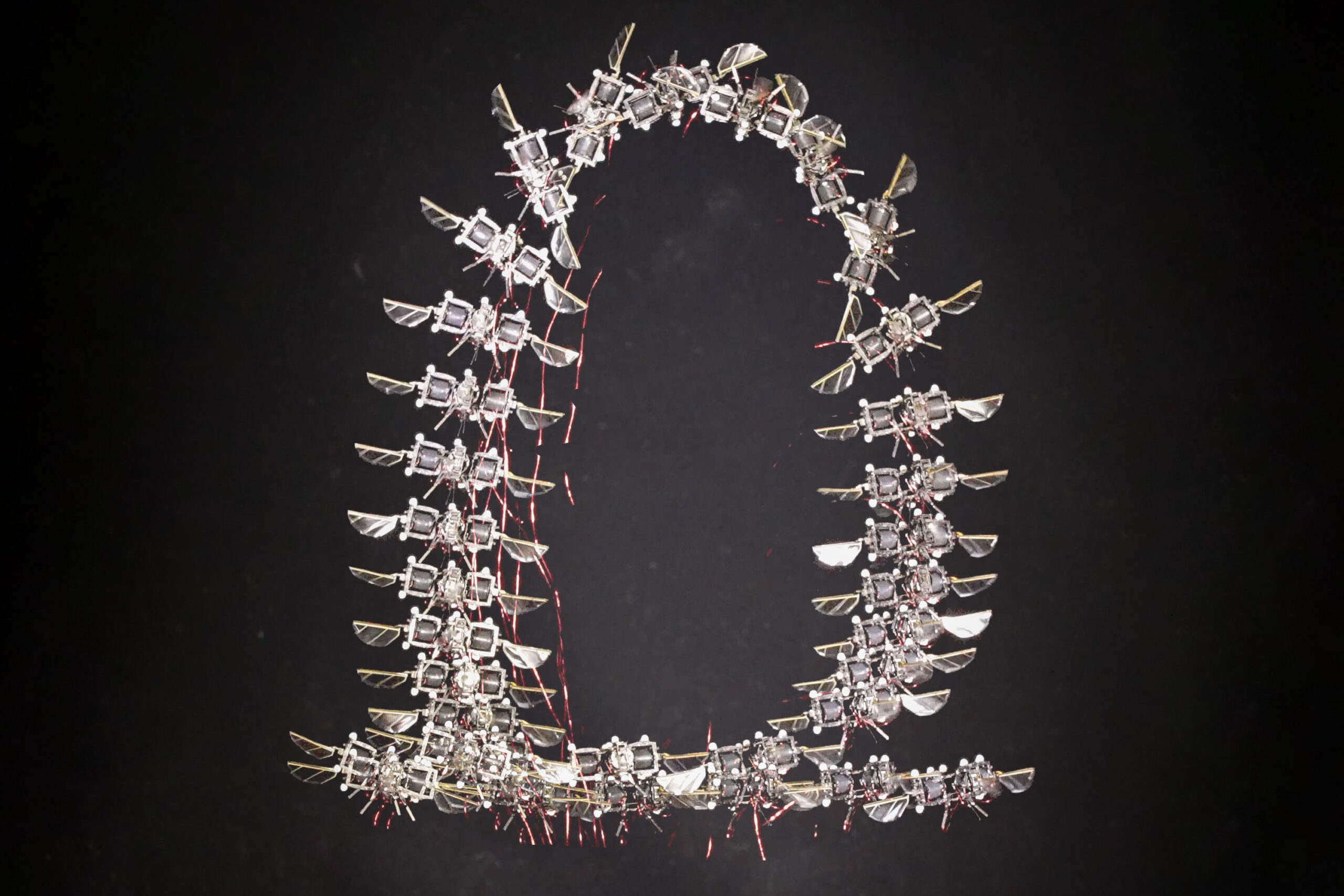Tech
Are bridges near you safe? This MRI-like scan may prevent disaster

Suyun Ham can’t take his eyes off a scanner. “Lower the sensors a little bit more,” Ham urges an assistant. Then a barrage of data floods in, filling computer screens for a diagnosis.
But Ham isn’t a medical doctor. Nor is his “patient” a living creature. An engineering professor from the University of Texas at Arlington, he is experimenting with a novel approach in bridge inspection.
Ham’s mobile-scanning system is part of efforts to make US infrastructure more heat-resilient. Unlike floods and tornados that can quickly destroy bridges, extreme heat is a silent killer that harms them over time, experts say.
“If temperatures are out of range, bridges can get damaged unexpectedly,” says Ham, who lives in the Dallas-Fort Worth area, where summer temperatures can exceed 100F (38C). “With our “MRI,” we can see what’s inside a bridge quickly.”
Bridge materials expand and contract in response to temperature fluctuations. While most are equipped with features to accommodate that movement, they were designed to withstand historically cooler temperatures, says Paul Chinowsky, a professor emeritus of civil engineering at the University of Colorado Boulder.
When temperatures hit a record high, bridges might behave in ways that engineers didn’t intend them to, he adds.Heat-swollen steel joints can impair the mobility of a swing bridge, making it unable to open or close—at least temporarily. Concrete also expands under heat. Once its expansion goes beyond a bridge’s original design limit, the concrete can crack, exposing it to moisture that can corrode internal metal components.
That’s an increasingly common scene around the world. In China, a concrete bridge broke in half because of brutal heat in 2022. That same year, London wrapped Hammersmith Bridge in giant pieces of foil to prevent it from overheating. And when the blistering sun baked Chicago’s DuSable drawbridge in 2018, its steel joints expanded and got stuck until firefighters hosed the bridge with cold water.
“Bridges are very susceptible,” Chinowsky says. “The hotter it gets compared to what typically it is, the more danger you have.”
‘A lot of headaches’
Hotter temperatures are baking US bridges at a time when their health is already deteriorating. The country has more than 600,000 bridges, almost half of which have exceeded their designed lifespan of 50 years, according to a 2025 report by the American Society of Civil Engineers.
With proper maintenance, many can last much longer, potentially exceeding 100 years, the industry group says. Still, about one in three bridges requires repair or replacement, according to an analysis published this year by the American Road and Transportation Builders Association.
Hussam Mahmoud, a professor at Vanderbilt University who has evaluated the structural integrity of about 90,000 steel-girder bridges across the US, found that many have aged prematurely, due in large part to the heat-accelerated malfunction of their expansion joints.
As the frequency and severity of heat waves increase with climate change, expansion joints, which connect two bridge spans, expand more often. That, coupled with the strain caused by debris or dirt accumulated in the joints over time, adds pressure to the structure, elevating the risk for a bridge to crack or buckle, Mahmoud says.
Although those defects don’t put a bridge in immediate danger of collapse, they need to be fixed to avoid further damage, which can be “a lot of headaches,” says Mahmoud.
With more than 4.9 billion trips taken across US bridges on any given day, bridge closures can take a toll on commerce and the economy, Mahmoud says. More damage also means higher maintenance costs. The US is already facing a $373 billion funding gap over the next 10 years to repair bridges properly, according to the American Society of Civil Engineers.Heat-induced damage can also cause bridges to malfunction at a time when the free movement of people is needed the most.
In June, a swing bridge in South Carolina got stuck for hours due to sweltering temperatures and was unable to open for ships to go through, delaying rescue efforts for a fatal boating accident.
Drive-by inspections
For Ham, better bridge monitoring is key. “Just like it is difficult to heal a human patient with stage-four cancer, it’d be too late to repair a bridge when there are a lot of defects,” he says.Ham, who spent a big chunk of his college time inspecting bridges, learned the limitations of the conventional method firsthand. He used to tap the bridge surface with a hammer and listen for hollow sounds that could indicate problems.
That hammer later evolved into more advanced devices, yet the time-consuming nature of manual inspection remains largely unchanged, Ham says. The conventional method also requires a bridge to shut down some of its lanes for inspection, a big ask for places such as Texas, which has 56,000-plus bridges.
While federal mandates typically require highway bridges to be inspected every two years, Ham and others at the University of Texas’s Smart Infrastructure and Testing Laboratory in Arlington want to help increase that frequency by introducing a new solution: a drive-through inspection.
Ham’s machine—a trailer loaded with dozens of electronics—is hauled by a pickup truck. On a sizzling afternoon in July, as the vehicle pulled the machine across a concrete bridge over a stream bed on the university campus, the tools generate mechanical waves that can propagate through concrete.
Sensors pick up the resulting bridge vibration signals, while a GPS device pins down where each signal comes from. Meanwhile, ground-penetrating radars emit pulses to create images of the structure under the bridge’s deck, and GoPros videotape the surface condition. The end goal, according to Ham, is to collect a wide range of data that enables engineers to identify cracks, voids and other anomalies.
The machine scanned the entire 5-feet-long bridge within seconds. By contrast, it would take hours for inspectors to complete the same job using the conventional method, according to Ham.
“There’s a lot of surface damage,” Ham says, pointing to a number of bright orange dots and stripes scattered across the dark blue background of one computer image generated from the onsite scanning. He also spots a cluster of tiny cracks, highlighted by a red rectangle.
Ham and his team then use artificial intelligence to refine the analysis and filter out “noises”—irregular vibration signals caused by a car driving by during the inspection, for instance. The engineers report their findings to bridge overseers for safety assessment and future repair work.
“It is better for time and efficiency,” says Mark Burwell, a bridge inspection coordinator at the Texas Department of Transportation whose agency has deployed Ham’s technology to inspect dozens of bridges since 2019. As inspectors no longer have to work next to moving traffic on a bridge, the automated inspection also helps put humans out of harm’s way, he adds.
For now, Ham’s “portable MRI” is only available for bridge inspection in the Lone Star state. Ham aims to scale up its deployment. To make that happen, the engineers will have to first perfect the innovation.
There have been many learning moments, Ham recalls. Once, a rough ride knocked off sensors, cutting an inspection mission short. (The machine is now equipped with a lift that lowers and raises it to avoid obstacles on the road.) On another occasion, the software grappled with the complexity of decoding signals from a concrete bridge covered with asphalt patches.
To help the AI better interpret signals, Ham and his team have turned their laboratory into a manufacturing hub of artificial defects. There, engineers soak metal sticks in brine to emulate corrosion. They also drill holes in concrete slabs to mimic cracks. By applying sensors and radars to examine those artificial defects, the engineers can pair different signals with different types of damage.
Even so, the machine is unlikely to catch all the heat-induced problems, according to Ham. For instance, searing temperatures can stress a bridge, but the machine can’t detect it until physical damage occurs.
But data collected from damaged bridges may pave a way for future protection, Ham says. That’s because, by comparing the number of cracks in bridges built with different methods and materials, the technology plays a role in helping regulators determine how to design structures more suitable for a hotter world.
“We’re like a medical doctor,” Ham says. “We can help them make a decision.”
2025 Bloomberg News. Distributed by Tribune Content Agency, LLC.
Citation:
Are bridges near you safe? This MRI-like scan may prevent disaster (2025, September 1)
retrieved 1 September 2025
from https://techxplore.com/news/2025-09-bridges-safe-mri-scan-disaster.html
This document is subject to copyright. Apart from any fair dealing for the purpose of private study or research, no
part may be reproduced without the written permission. The content is provided for information purposes only.
Tech
BMW Is Betting Big on the New iX3. The Good News Is It’s Superb

BMW’s first car on its new EV platform has finally arrived. But will a big range, thumping charging tech, and a new driving brain that aims to deliver the ultimate ride be enough to beat China?
Source link
Tech
MIT engineers design an aerial microrobot that can fly as fast as a bumblebee

In the future, tiny flying robots could be deployed to aid in the search for survivors trapped beneath the rubble after a devastating earthquake. Like real insects, these robots could flit through tight spaces larger robots can’t reach, while simultaneously dodging stationary obstacles and pieces of falling rubble.
So far, aerial microrobots have only been able to fly slowly along smooth trajectories, far from the swift, agile flight of real insects — until now.
MIT researchers have demonstrated aerial microrobots that can fly with speed and agility that is comparable to their biological counterparts. A collaborative team designed a new AI-based controller for the robotic bug that enabled it to follow gymnastic flight paths, such as executing continuous body flips.
With a two-part control scheme that combines high performance with computational efficiency, the robot’s speed and acceleration increased by about 450 percent and 250 percent, respectively, compared to the researchers’ best previous demonstrations.
The speedy robot was agile enough to complete 10 consecutive somersaults in 11 seconds, even when wind disturbances threatened to push it off course.
Credit: Courtesy of the Soft and Micro Robotics Laboratory
“We want to be able to use these robots in scenarios that more traditional quad copter robots would have trouble flying into, but that insects could navigate. Now, with our bioinspired control framework, the flight performance of our robot is comparable to insects in terms of speed, acceleration, and the pitching angle. This is quite an exciting step toward that future goal,” says Kevin Chen, an associate professor in the Department of Electrical Engineering and Computer Science (EECS), head of the Soft and Micro Robotics Laboratory within the Research Laboratory of Electronics (RLE), and co-senior author of a paper on the robot.
Chen is joined on the paper by co-lead authors Yi-Hsuan Hsiao, an EECS MIT graduate student; Andrea Tagliabue PhD ’24; and Owen Matteson, a graduate student in the Department of Aeronautics and Astronautics (AeroAstro); as well as EECS graduate student Suhan Kim; Tong Zhao MEng ’23; and co-senior author Jonathan P. How, the Ford Professor of Engineering in the Department of Aeronautics and Astronautics and a principal investigator in the Laboratory for Information and Decision Systems (LIDS). The research appears today in Science Advances.
An AI controller
Chen’s group has been building robotic insects for more than five years.
They recently developed a more durable version of their tiny robot, a microcassette-sized device that weighs less than a paperclip. The new version utilizes larger, flapping wings that enable more agile movements. They are powered by a set of squishy artificial muscles that flap the wings at an extremely fast rate.
But the controller — the “brain” of the robot that determines its position and tells it where to fly — was hand-tuned by a human, limiting the robot’s performance.
For the robot to fly quickly and aggressively like a real insect, it needed a more robust controller that could account for uncertainty and perform complex optimizations quickly.
Such a controller would be too computationally intensive to be deployed in real time, especially with the complicated aerodynamics of the lightweight robot.
To overcome this challenge, Chen’s group joined forces with How’s team and, together, they crafted a two-step, AI-driven control scheme that provides the robustness necessary for complex, rapid maneuvers, and the computational efficiency needed for real-time deployment.
“The hardware advances pushed the controller so there was more we could do on the software side, but at the same time, as the controller developed, there was more they could do with the hardware. As Kevin’s team demonstrates new capabilities, we demonstrate that we can utilize them,” How says.
For the first step, the team built what is known as a model-predictive controller. This type of powerful controller uses a dynamic, mathematical model to predict the behavior of the robot and plan the optimal series of actions to safely follow a trajectory.
While computationally intensive, it can plan challenging maneuvers like aerial somersaults, rapid turns, and aggressive body tilting. This high-performance planner is also designed to consider constraints on the force and torque the robot could apply, which is essential for avoiding collisions.
For instance, to perform multiple flips in a row, the robot would need to decelerate in such a way that its initial conditions are exactly right for doing the flip again.
“If small errors creep in, and you try to repeat that flip 10 times with those small errors, the robot will just crash. We need to have robust flight control,” How says.
They use this expert planner to train a “policy” based on a deep-learning model, to control the robot in real time, through a process called imitation learning. A policy is the robot’s decision-making engine, which tells the robot where and how to fly.
Essentially, the imitation-learning process compresses the powerful controller into a computationally efficient AI model that can run very fast.
The key was having a smart way to create just enough training data, which would teach the policy everything it needs to know for aggressive maneuvers.
“The robust training method is the secret sauce of this technique,” How explains.
The AI-driven policy takes robot positions as inputs and outputs control commands in real time, such as thrust force and torques.
Insect-like performance
In their experiments, this two-step approach enabled the insect-scale robot to fly 447 percent faster while exhibiting a 255 percent increase in acceleration. The robot was able to complete 10 somersaults in 11 seconds, and the tiny robot never strayed more than 4 or 5 centimeters off its planned trajectory.
“This work demonstrates that soft and microrobots, traditionally limited in speed, can now leverage advanced control algorithms to achieve agility approaching that of natural insects and larger robots, opening up new opportunities for multimodal locomotion,” says Hsiao.
The researchers were also able to demonstrate saccade movement, which occurs when insects pitch very aggressively, fly rapidly to a certain position, and then pitch the other way to stop. This rapid acceleration and deceleration help insects localize themselves and see clearly.
“This bio-mimicking flight behavior could help us in the future when we start putting cameras and sensors on board the robot,” Chen says.
Adding sensors and cameras so the microrobots can fly outdoors, without being attached to a complex motion capture system, will be a major area of future work.
The researchers also want to study how onboard sensors could help the robots avoid colliding with one another or coordinate navigation.
“For the micro-robotics community, I hope this paper signals a paradigm shift by showing that we can develop a new control architecture that is high-performing and efficient at the same time,” says Chen.
“This work is especially impressive because these robots still perform precise flips and fast turns despite the large uncertainties that come from relatively large fabrication tolerances in small-scale manufacturing, wind gusts of more than 1 meter per second, and even its power tether wrapping around the robot as it performs repeated flips,” says Sarah Bergbreiter, a professor of mechanical engineering at Carnegie Mellon University, who was not involved with this work.
“Although the controller currently runs on an external computer rather than onboard the robot, the authors demonstrate that similar, but less precise, control policies may be feasible even with the more limited computation available on an insect-scale robot. This is exciting because it points toward future insect-scale robots with agility approaching that of their biological counterparts,” she adds.
This research is funded, in part, by the National Science Foundation (NSF), the Office of Naval Research, Air Force Office of Scientific Research, MathWorks, and the Zakhartchenko Fellowship.
Tech
Thursday’s Cold Moon Is the Last Supermoon of the Year. Here’s How and When to View It

A cold supermoon is on its way. On December 4, Earth’s satellite will delight us with one of the last astronomical spectacles of 2025. Not only will it be the last full moon of the year, but it’s also a cold moon—which refers to the frigid temperatures typical of this time of year—and, finally, a supermoon. Here’s how and when best to enjoy this spectacle of the year-end sky.
What Is a Supermoon?
The term supermoon refers to a full moon that occurs when our satellite is at perigee, the point at which its orbit brings it closest to our planet. (The moon’s orbit is elliptical, and its distance from Earth varies between about 407,000 km at apogee, the point of maximum distance, and about 380,000 at perigee.)
In addition to being the third consecutive supermoon of the year, as reported by EarthSky, it will be about 357,000 km away from us, making it the second-closest full Moon of the year. Consequently it will also be the second-largest and brightest.
Although most of us won’t notice any difference in size compared to a normal full moon (it appears up to 8 percent larger to us), its brightness could exceed that of an ordinary full Moon by 16 percent. This time, moreover, it will be 100 percent illuminated just 12 hours after its perigee.
The Cold Supermoon
In addition to its name, which refers to the cold temperatures of this period, December’s full moon will be the last of 12 full moons in 2025 and the highest of the year. With the winter solstice approaching on December 21, the sun is at its lowest point in the sky, so the full moon is at its highest point. In other words, this means that the super cold moon will be particularly high in the sky. As EarthSky points out, however, it is not the closest full Moon to the December 21 solstice. While it occurs 17 days before, the first full moon of 2026 will occer on January 3—just 12 days ater teh solstice. That will be the fourth and last consecutive supermoon.
How to Enjoy the Show
Although the moon may appear full both the night before and the night after, the exact time of the full moon is scheduled for 6:14 pm ET on Thursday, December 4. In general, moonrise is the best time to be subject to the so-called lunar illusion, during which the moon appears larger than usual to us. NASA still doesn’t have a scientific explanation for why this happens, but as you might expect, the effect is greatest during a supermoon. Weather permitting, therefore, find an elevated place or meadow with an unobstructed view of the eastern horizon and enjoy the last moon show of the year.
This story originally appeared on WIRED Italia and has been translated from Italian.
-

 Sports3 days ago
Sports3 days agoIndia Triumphs Over South Africa in First ODI Thanks to Kohli’s Heroics – SUCH TV
-

 Tech4 days ago
Tech4 days agoGet Your Steps In From Your Home Office With This Walking Pad—On Sale This Week
-

 Fashion3 days ago
Fashion3 days agoResults are in: US Black Friday store visits down, e-visits up, apparel shines
-

 Entertainment3 days ago
Entertainment3 days agoSadie Sink talks about the future of Max in ‘Stranger Things’
-

 Politics3 days ago
Politics3 days agoElon Musk reveals partner’s half-Indian roots, son’s middle name ‘Sekhar’
-

 Tech3 days ago
Tech3 days agoPrague’s City Center Sparkles, Buzzes, and Burns at the Signal Festival
-
Uncategorized1 week ago
[CinePlex360] Please moderate: “Americans would
-

 Tech1 week ago
Tech1 week agoWake Up—the Best Black Friday Mattress Sales Are Here


















